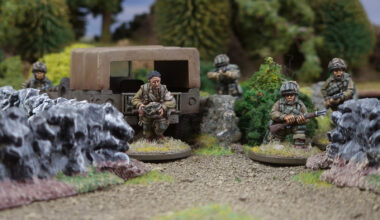After the evacuation of the British Expeditionary Force from Dunkirk, the war in Europe seemed lost. Nazi Germany was master of the continent, and Britain stood alone. The British military and public quailed before the threat of invasion, and Hitler ordered Unternehmen Seelöwe (Operation Sea Lion) into motion. Sea Lion was ambitious in the extreme, an amphibious assault that depended on Germany having mastery of both sea and air. Historically, the Royal Air Force’s heroics during the Battle of Britain prevented the latter, while the Kriegsmarine’s lacklustre surface fleet precluded the former, and the whole thing was called off. In another time, however…
The Bolt Action Campaign books Operation Sea Lion and Operation Gigant allow you to play through a hypothetical 1940 where the invasion was actually carried out, with subsequent German reinforcements provided by glider assault. Uniquely among Bolt Action books, Sea Lion and Gigant do not deal with real history, and as such we have an enormous amount of creative freedom and ‘wiggle room’ to play with; with author John Lambshead providing plenty of interesting and characterful new units to add to our games. In the years since their initial release, Blood Red Skies, Victory at Sea, and (most recently) Combined Arms have emerged, massively expanding the possibilities for wargaming within the alternate reality of Sea Lion. Let’s take a trip to the Twilight Zone!
In this reality, Operation Sea Lion is made possible with the naval co-operation of Italy and France (Britain having decided not to destroy the French fleet at Mers-El-Kebir) and a rather better showing by the Luftwaffe than they managed historically. Despite this, the initial amphibious and airborne landings were massively disjointed, and while a foothold in Kent was secured, the German supply situation was precarious. A great Royal Naval victory in the Channel on D-Day+10 prevented a vital supply convoy reaching the beachhead, and by D-Day+15 the exhausted and starving German forces were beginning to surrender. This prompted an ambitious airborne invasion of Lincolnshire, aiming to drive down through the East Midlands and link up with the southern beachhead. While this ultimately bogged down at Peterborough, the twin campaigns give us a huge variety of scenarios and forces to work with. Let’s start with a look at the Germans!
The forces available to German players are naturally somewhat limited – one way or another, it all has to come across the Channel – particularly when it comes to heavy armour. Now, this is still 1940, so there’s no chance of Tigers roaming the Home Counties, but when you consider the state of the British tank arm of the period, even a Panzer III or early IV starts to look pretty menacing! The question, of course, is how to get one to the beachhead. A barge is the obvious (and boring) choice, but that’s not going to stand up to the rigours of being in the first wave of an amphibious assault! They’re too heavy to be floated ashore (leave that to the lighter Panzer IIs), but why not… just drive them along the seabed? The weird and wonderful Tauchpanzer conversions were designed to do just that (and were experimented with in real life – I’m not joking!), guided by radio and a compass. This must have been frankly terrifying for the crews, never mind to the British Home Guard who would have been confronted with the site of Panzers emerging from the surf. For the infantry, there are also a number of landing craft of various sizes – just what you’ll need to get your Soldaten ashore. In most other respects, the German landing forces are more or less what you’d expect – plenty of infantry without much heavy weaponry in support.
For German players looking to enjoy the early successes of the Fallschirmjäger paratroops in the campaign, there’s an airborne selector perfectly representing the rapid capture of the airstrip at Lympne – this is a fantastic opportunity to put together an early-war Fallschirmjäger army, which isn’t often seen on the tabletop and (as an all-Veteran army) will be in stark contrast to their British opposition. For the German player after something really different, there are also a number of ‘fifth column’ options, including the Brandenburger infiltration commandos (able to sneak in close thanks to their Disguised special rule), the British Union of Fascists attempting to stage their own uprising under Sir Oswald Mosley, and the unique gangster ‘platoon’ – all amazing modelling opportunities and certain to provide some… unusual gaming moments!
With the failure of Sea Lion necessitating the reinforcing assault of Gigant, even more weird and wonderful units present themselves for the Germans. These range from the IRA throwing their lot in with the invaders (who had offered a united Ireland post-war) and somehow managing to reactivate a WWI-era Mark IV tank (available from our sister company Skytrex), to the many captured French tanks of the Deutsches England Korps (plenty of great painting and modelling opportunities), and the frankly bonkers Flugpanzer I. For any German speakers, yes, you’re correct – a flying Panzer I! The forces of Gigant tend towards the motorised, featuring many light tanks and the associated tabletop mayhem that brings! Of course, any airborne assault requires air superiority – the perfect excuse for a few games of Blood Red Skies!



Opposing the German invasion is a rag-tag band of British regulars, hastily-mustered Local Defence Volunteers (LDV), local militia units, boy scouts, and local sports clubs! With units ranging from the excellent and deadly (Royal Navy infantry sections) to the somewhat ridiculous (the local cricket club, complete with lethally fast bowlers!), all echelons of British society are mustered to defend their island. While this can lead to some rather comical moments (I’ve personally witnessed a game where Oswald Mosley was skewered by a ladies’ archery club while attacking a pub!), it can also give some absolutely fascinating small-scale actions. With little in the way of heavy armour or artillery, Sea Lion lends itself fantastically well to close-quarters urban infantry combat, particularly with asymmetric scenarios.


Sea Lion and Gigant were, at their core, written to be played as campaigns. This makes the invasion of Britain a perfect candidate for Combined Arms – one of the maps included in the box is perfect for the Channel crossing and early landings, and you can always make your own to include the wider British Isles as well! With Combined Arms, you can fight Sea Lion from start to finish, on land, air, and sea – can the Royal Navy fight through the combined Kriegsmarine, Regia Marina, and Marine Nationale to scupper the landing fleet, or can the Luftwaffe gain the upper hand and open the skies for vital supply flights (and flying tanks!)? Can the DEK drive south to London, or will the British Army manage to block them at Nottingham (where for some reason Finch Close has been designated a target of the utmost strategic importance)? Grab your best Blood Red Skies, Bolt Action, and Victory at Sea players – it’s time to change (pretend) history!























5 comments
We are hoping to run some little skirmish games as part of a campaign of sealion later in the year in our store, i think its such an interesting what if scenario
I would include Dad’s army in this campaign.
I always do… They (and their special rules) are great fun for a none-to-serious game of Bolt Action.
Of course, in reality Britiain did not stand alone in 1940, as the other nations of the Commonwealth were also still at war with Germany. The ground forces arrayed to defend the UK in 1940 included the Australian 18th & 25th Infantry Brigades, the Canadian 1st Infantry Division and the New Zealand Brigade Group. So, players with those armies can also enjoy the scenarios in both of these campaign books.
I agree